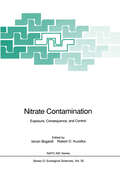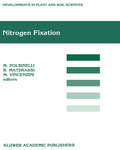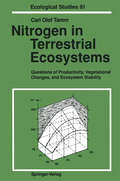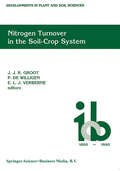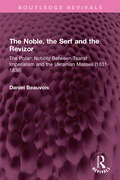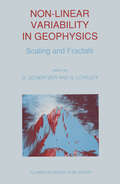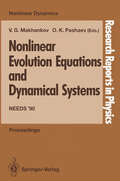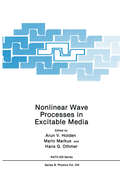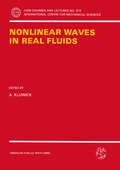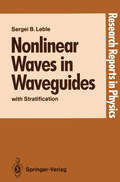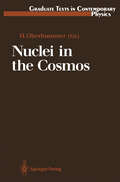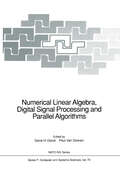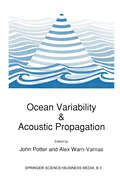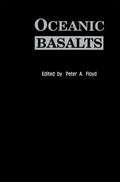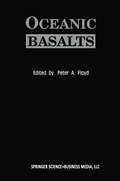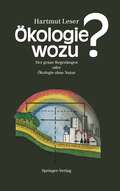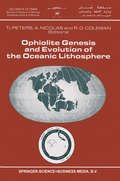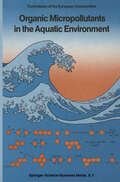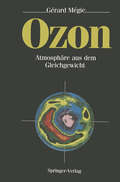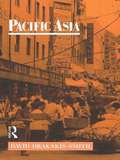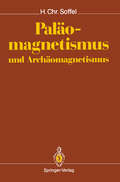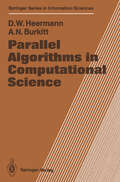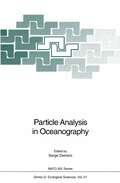- Table View
- List View
Nitrate Contamination: Exposure, Consequence, and Control (Nato ASI Subseries G: #30)
by Wilma G. Ennenga Robert D. Kuzelka IstvanBogárdiThe nitrate content of drinking water is rising at an alarming rate in several regions of NATO countries and elsewhere in the world. The increase is due to lack of proper sewage treatment, and primarily to excess fertilizer application. Also, eutrophication in several coastal areas is triggered by high nitrate concentrations. The main purpose of this book is to integrate scientific knowledge related to exposure assessment, health consequences and control of nitrate contamination in water. The motivation is related to the magnitude, the possible adverse health effects, and the high cost of control ling nitrate contamination. Future research tasks are defined by an interaction among hydro logists, toxicologists and environmental engineers in an integrated framework for nitrate risk management. The target readership of this book is a mix of university colleagues, practitioners from both the private and public sectors and advanced graduate students working with the hydrological, health science or environmental engineering aspects of nitrate contamination. The main conclusions include: 1. For risk assessment purposes, knowledge and sufficiently accurate models are available to predict nitrate load and its fate in water under changes in land use. 2. Once agricultural exposure controls are implemented, the response times in ground water may be so long as to make controls unrealistic. 3. It is still unknown whether agricultural best management practice is a compromise between nitrate risk reduction and agricultural revenue. 4. The current drinking water guidelines of 10 mg/L NOrN need not be changed.
Nitrogen Fixation: Proceedings of the Fifth International Symposium on Nitrogen Fixation with Non-Legumes, Florence, Italy, 10–14 September 1990 (Developments in Plant and Soil Sciences #48)
by M. Polsinelli R. Materassi M. VincenziniThe Fifth International Symposium on Nitrogen Fixation with Non-legumes was held in Florence (Italy) on 10-14 September, 1990. Earlier Symposia of this series were held in Piracicaba (Brazil), Banf Alberta (Canada), Helsinki (Finland) and Rio De Janeiro (Brazil). The Symposium's main objectives were to bring together scientists working in many different fields of nitrogen fixation, to stimulate discussion on this important process and to have an appraisal of the most recent studies concerning nitrogen fixation with non-legumes. The Symposium was attended by 230 scientists from 32 different countries. This volume collects the contributions of 65 lectures and 87 posters, which are an up-to-date account of the state of knowledge on biological nitrogen fixation with non-legumes. The book provides a valuable reference source not only for specialists in nitrogen fixation, but also for researchers working on related aspects of agronomy, biochemistry, genetics, microbiology, molecular biology and plant physiology. It is with great pleasure that we aknowledge the contributions of the authors in assuring the prompt pubblication of this volume. We would also like to express our thanks to Kluwer Academic Publishers B.V. for the publication of these Proceedings. M. Polsinelli R. Materassi M. Vincenzini ORGANIZING COMMITTEE President M. Polsinelli M. Vincenzini Secretary F. Favilli Treasurer E. Galli E. Gallori L. Giovannetti R. Materassi M.P. Nuti M.R. Tredici SCIENTIFIC COMMITTEE M. Bazzicalupo Florence, Italy H. Bothe Cologne, West Germany R.H. Burris Madison, U.S.A.
Nitrogen in Terrestrial Ecosystems: Questions of Productivity, Vegetational Changes, and Ecosystem Stability (Ecological Studies #81)
by Carl O. TammNitrogen is a key element in ecosystem processes. Aspects of local and global changes in nitrogen in both undisturbed and disturbed conditions are discussed. Environmental changes caused by pollution from nitrogenous compounds and changes in landuse are also described. Organisms, plants, animals and microorganisms are all affecting nitrogen supply. Emphasis is placed on natural and anthropogenic transfer of nitrogen between ecosystems and also on the interaction of nitrogen with other bioelements.
Nitrogen Turnover in the Soil-Crop System: Modelling of Biological Transformations, Transport of Nitrogen and Nitrogen Use Efficiency. Proceedings of a Workshop help at the Institute for Soil Fertility Research, Haren, The Netherlands, 5–6 June 1990 (Developments in Plant and Soil Sciences #44)
by J. J. Groot P. De Willigen E. J. VerberneIn the Netherlands the Institute for Soil Fertility Research plays a major role in soil biological, soil physical and plant nutritional research on the availability of nitrogen to crops. Main subjects of research are nitrogen turnover in the crop-soil ecosystem through biological transformations, nitrogen transport through the soil and nitrogen losses by leaching, denitrification and volatilization, and nitrogen use efficiency of various crops and cropping systems. The current knowledge in the different fields of research is integrated in simulation models. Simulation models not only make it possible to summarize and structure knowledge, but also, after verification, to extra- late the knowledge to situations different from the situations that have actually been studied. Such research is also carried out in other European and non-European countries. To compare the various simulation models currently in use, a workshop was organized by the Institute for Soil Fertility Research on 5-6 June 1990 on the occasion of its centennial. The title of the workshop was 'Nitrogen turnover in the soil-crop ::cosystem: modelling of biological transformations, transport of nitrogen and nitrogen use efficiency'. The 40 Jarticipants, who came from Canada and various European countries, were requested to run their model with data Jrovided by the Institute prior to the workshop. Data from 18 cases were made available to the participants: three ocations, three treatments, and two seasons.
The Noble, the Serf and the Revizor: The Polish Nobility Between Tsarist Imperialism and the Ukrainian Masses (1831-1836) (Routledge Revivals)
by Daniel BeauvoisFirst published in 1991, The Noble, the Serf and the Revizor is a historical and sociological study of the Polish nobility of the Western Ukraine between the two great uprisings that shook Poland in the 19th century is based almost entirely on original, unpublished documents. Daniel Beauvois throws an entirely new light on the Polish nobility of the Ukraine, on its development and particular mentality. Furthermore, his research reveals mechanisms of domination and assimilation, which the Czarist bureaucracy can be said to have pioneered long before the Soviet empire. During this period, the Russian revizor, a key figure in the social drama described in these pages, ruthlessly lowered the status of the majority of the Polish nobles in the Ukraine. Thereafter, their fate was defined by two basic realities: poverty and the decline of their national identity and social status. Only a small minority of rich landowners survived. The price they paid was total political subservience, a subservience which gave rise to an increasingly conservative mentality and the loss of all real contact with the Polish national movement. This book will be of interest to students of history, political science, sociology and international relations.
The Noble, the Serf and the Revizor: The Polish Nobility Between Tsarist Imperialism and the Ukrainian Masses (1831-1836) (Routledge Revivals)
by Daniel BeauvoisFirst published in 1991, The Noble, the Serf and the Revizor is a historical and sociological study of the Polish nobility of the Western Ukraine between the two great uprisings that shook Poland in the 19th century is based almost entirely on original, unpublished documents. Daniel Beauvois throws an entirely new light on the Polish nobility of the Ukraine, on its development and particular mentality. Furthermore, his research reveals mechanisms of domination and assimilation, which the Czarist bureaucracy can be said to have pioneered long before the Soviet empire. During this period, the Russian revizor, a key figure in the social drama described in these pages, ruthlessly lowered the status of the majority of the Polish nobles in the Ukraine. Thereafter, their fate was defined by two basic realities: poverty and the decline of their national identity and social status. Only a small minority of rich landowners survived. The price they paid was total political subservience, a subservience which gave rise to an increasingly conservative mentality and the loss of all real contact with the Polish national movement. This book will be of interest to students of history, political science, sociology and international relations.
Non-Linear Variability in Geophysics: Scaling and Fractals
by D. Schertzer S. Lovejoyconsequences of broken symmetry -here parity-is studied. In this model, turbulence is dominated by a hierarchy of helical (corkscrew) structures. The authors stress the unique features of such pseudo-scalar cascades as well as the extreme nature of the resulting (intermittent) fluctuations. Intermittent turbulent cascades was also the theme of a paper by us in which we show that universality classes exist for continuous cascades (in which an infinite number of cascade steps occur over a finite range of scales). This result is the multiplicative analogue of the familiar central limit theorem for the addition of random variables. Finally, an interesting paper by Pasmanter investigates the scaling associated with anomolous diffusion in a chaotic tidal basin model involving a small number of degrees of freedom. Although the statistical literature is replete with techniques for dealing with those random processes characterized by both exponentially decaying (non-scaling) autocorrelations and exponentially decaying probability distributions, there is a real paucity of literature appropriate for geophysical fields exhibiting either scaling over wide ranges (e. g. algebraic autocorrelations) or extreme fluctuations (e. g. algebraic probabilities, divergence of high order statistical moments). In fact, about the only relevant technique that is regularly used -fourier analysis (energy spectra) -permits only an estimate of a single (power law) exponent. If the fields were mono-fractal (characterized by a single fractal dimension) this would be sufficient, however their generally multifractal character calls for the development of new techniques.
Nonlinear Evolution Equations and Dynamical Systems: Needs ’90 (Research Reports in Physics)
by Vladimir G. Makhankov Oktay K. PashaevProceedings of the 6th International Workshop, 16-26 July 1990, Dubna, USSR
Nonlinear Wave Processes in Excitable Media (Nato Science Series B: #244)
by Arunn V. Holden Mario Markus Hans G. OthmerProceedings of a NATO ARW held in Leeds, UK, September 11-15, 1989
Nonlinear Waves in Real Fluids (CISM International Centre for Mechanical Sciences #315)
by A. KluwickThe study of materials which exhibit new and unconventional properties is of central importance for the devel- opment of advanced and refined technologies in many fields of engineering science. In this connection there has been a rapidly growing interest in real fluid effects on wave phenomena in the past few years. A prominent example is provided by Bethe-Zel'dovich-Thompson (BZT) fluids which have the distinguishing feature that they exhibit negative nonlinearity over a finite range of temperature and pressures in the pure vapour phase. However, two phase flows with and without phase change are an even richer source of new unexpected and previously thought impossible phenomena. Topics covered by this volume include waves in gases near the critical point, waves in retrograde fluids, temperature waves in superfluid helium and density waves in suspensions of particles in liquids. Clearly, the aim of the various contributions is twofold. First, they are intended to provide scientists and engineers working in these and related areas with an overview of various new physical phenomena as for example expansion shocks, sonic shocks, shock splitting, evaporation and liquafaction shocks and the experimental techniques needed to study these phenomena. Second, an attempt is made to discuss aspects of their mathematical modeling with special emphasis on properties which these phenomena have in common.
Nonlinear Waves in Waveguides: with Stratification (Research Reports in Physics)
by Sergei B. LebleS.B. Leble's book deals with nonlinear waves and their propagation in metallic and dielectric waveguides and media with stratification. The underlying nonlinear evolution equations (NEEs) are derived giving also their solutions for specific situations. The reader will find new elements to the traditional approach. Various dispersion and relaxation laws for different guides are considered as well as the explicit form of projection operators, NEEs, quasi-solitons and of Darboux transforms. Special points relate to: 1. the development of a universal asymptotic method of deriving NEEs for guide propagation; 2. applications to the cases of stratified liquids, gases, solids and plasmas with various nonlinearities and dispersion laws; 3. connections between the basic problem and soliton- like solutions of the corresponding NEEs; 4. discussion of details of simple solutions in higher- order nonsingular perturbation theory.
Nuclei in the Cosmos (Graduate Texts in Contemporary Physics)
by J. H. Applegate J. J. Cowan F. Käppeler H.V. Klapdor-Kleingrothaus K. Langanke R. A. Malaney H. Oberhummer B.E.J. Pagel C. Rolfs G. Schatz G. Staudt F. K. Thielemann J. Vervier M. WiescherNuclear astrophysics as it stands today is a fascinating science. Even though, compared to other scientific fields, it is a young discipline which has developed only in this century, it has answered many questions concerning the under standing of our cosmos. One of these great achievements was the concept of nucleosynthesis, the creation of the elements in the early universe in interstellar matter and in stars. Nuclear astrophysics has continued, to solve many riddles of the evolution of the myriads of stars in our cosmos. This review volume attempts to provide an overview of the current status of nuclear astrophysics. Special emphasis is given to the interdisciplinary nature of the field: astronomy, nuclear physics, astrophysics and particle physics are equally involved. One basic effort of nuclear astrophysics is the collection of ob servational facts with astronomical methods. Laboratory studies of the nuclear processes involved in various astrophysical scenarios have provided fundamen tal information serving both as input for and test of astrophysical models. The theoretical understanding of nuclear reaction mechanisms is necessary, for example, to extrapolate the experimentally determined reaction rates to the thermonuclear energy range, which is relevant for the nuclear processes in our cosmos. Astrophysical models and calculations allow us to simulate how nuclear processes contribute to driving the evolution of stars, interstellar matter and the whole universe. Finally, elementary particle physics also plays an important role in the field of nuclear astrophysics, for instance through weak interaction processes involving neutrinos.
Numerical Linear Algebra, Digital Signal Processing and Parallel Algorithms (NATO ASI Subseries F: #70)
by Gene H. Golub Paul Van DoorenNumerical linear algebra, digital signal processing, and parallel algorithms are three disciplines with a great deal of activity in the last few years. The interaction between them has been growing to a level that merits an Advanced Study Institute dedicated to the three areas together. This volume gives an account of the main results in this interdisciplinary field. The following topics emerged as major themes of the meeting: - Singular value and eigenvalue decompositions, including applications, - Toeplitz matrices, including special algorithms and architectures, - Recursive least squares in linear algebra, digital signal processing and control, - Updating and downdating techniques in linear algebra and signal processing, - Stability and sensitivity analysis of special recursive least squares problems, - Special architectures for linear algebra and signal processing. This book contains tutorials on these topics given by leading scientists in each of the three areas. A consider- able number of new research results are presented in contributed papers. The tutorials and papers will be of value to anyone interested in the three disciplines.
Ocean Variability & Acoustic Propagation
by J. Potter A. Warn-VarnasFifteen years ago NATO organised a conference entitled 'Ocean Acoustic Modelling'. Many of its participants were again present at this variability workshop. One such participant. in concluding his 1975 paper, quoted the following from a 1972 literature survey: ' ... history presents a sad lack of communications between acousticians and oceanographers' Have we done any better in the last 15 years? We believe so, but only moderately. There is still a massive underdeveloped potential for acousticians and oceanographers to make significant progress together. Currently, the two camps talk together insufficiently even to avoid simple misun derstandings. such as those in Table 1. Table 1 Ocsanographic and acoustic jargon (from an idea by Pol/ardi Jargon Oceanographic use Acoustic use dbordB decibar (depth in m) decibel (energy level) PE primitive equations parabolic equations convergence zone converging currents converging rays (downwelling water) (high energy density) front thermohaline front wave, ray or time front speed water current speed sound propagation speed 1 The list goes on.
Oceanic Basalts
by P.A. FloydOceanic basalts are the most abundant rock type found at the earth's surface, and as such they have been the subject of considerable research, particularly since the concept of sea-floor spreading became widely accepted. This book provides a review of these rocks, first dicussing how we sample the ocean floor and what we know about the structure of the oceanic crust, followed by an overview of the various regional settings (Pacific crust, Atlantic crust, marginal basins, seamounts and islands) and finally examines the main processes (and their interactions) which prevail during the generation and emplacement of oceanic basalt magmas. This is a volume for geologists, geochemists and geophysicists and a source of reference for advanced undergraduate students and postgraduates in these disciplines.
Oceanic Basalts
by P.A. FloydBasalt is the most voluminous of all the igneous rocks. Extensive field, experimental, petrographic and geochemical studies of basalt have provided us with a considerable understanding of igneous petrogenesis, plate tectonics, and crust-mantle interaction and exchange. One important aspect of geology that has developed over the last few decades is the study of oceanic basalts. The ocean basins cover about two thirds of the earth's surface and are floored by a basement of oceanic basalt that is continuously undergoing generation at spreading centres and destruction at subduction zones, a process which throughout geological time is recognized as the principal means of generating new crust. The study of oceanic basalts enables us to understand better the generation and recycling of crustal materials (including the continental crust), and the exchange between oceanic crust and seawater via hydrothermal activity. Compositional variations displayed by oceanic basalts provide windows into the mantle, and the identification of isotopically-distinct mantle reservoirs demonstrates that the source of oceanic basalts is heterogeneous and is controlled by convection and reservoir interactions within the mantle.
Ophiolite Genesis and Evolution of the Oceanic Lithosphere: Proceedings of the Ophiolite Conference, held in Muscat, Oman, 7–18 January 1990 (Petrology and Structural Geology #5)
by Tj Peters A. Nicolas R. ColemanProceedings of the Ophiolite Conference, held in Muscat, Oman, January 7-18, 1990
Organic Micropollutants in the Aquatic Environment: Proceedings of the Sixth European Symposium, Held in Lisbon, Portugal, May 22–24, 1990
by G. Angeletti A. BjørsethMore than 10 years after the "First European Symposium on Organic Micropollutants in the Aquatic Environment", the "Sixth Symposium" was held in Lisbon (Portugal) from 22 to 24 May 1990. The Symposium was organised within the framework of the Concerted Action COST 641 * which is included in the Fourth R&D Programme on the Environment of the Commission of the European Communities expiring at the end of 1990. After restructuring the Concerted Action in 1984, particular attention has been devoted to fate and transformation of organic micropollutants in the aquatic environment. Therefore, a major aim of the Symposium was to review current studies and progress in these areas, besides more general aspects related to analytical methodologies and behaviour of pollutants during water treatment processes. This volume contains the plenary papers presented in the following sessions at the Symposium: - Multidisciplinary studies - Partitioning of organic micropollutants in the aquatic environment - Novel analytical techniques in environmental chemistry - Monitoring micropollutant - Degradation of organic micropollutants during field conditions - Reclamation of polluted ground water - Chemical and photochemical oxidation - Future of environmental chemistry. In addition, extended versions of posters are included, covering the four topics which are dealt within the four Working Parties forming the structure of the Concerted Action: 1. Analytical methodologies 2. Transport and distribution 3. Transformation reactions 4. Water treatment. We believe that the Proceedings give a good overview of current activities in these fields of research in Europe.
Pacific Asia (Routledge Introductions to Development)
by David W. Drakakis-SmithPacific Asia - from Burma to Papua New Guinea to Japan - is the most dynamic and productive region in the developing world, the result of an economic explosion fuelled by industrial activity. This is where the Green Revolution began, where more women are employed in factory work than anywhere alse; the region is also the most predominately socialist in the Third World. David W. Smith assesses Pacific Asia both in terms of its historical development and the present global system, placing general development issues in their local contexts. The book will be an invaluable introduction to the region.
Pacific Asia (Routledge Introductions to Development)
by David W. Drakakis-SmithPacific Asia - from Burma to Papua New Guinea to Japan - is the most dynamic and productive region in the developing world, the result of an economic explosion fuelled by industrial activity. This is where the Green Revolution began, where more women are employed in factory work than anywhere alse; the region is also the most predominately socialist in the Third World. David W. Smith assesses Pacific Asia both in terms of its historical development and the present global system, placing general development issues in their local contexts. The book will be an invaluable introduction to the region.
Paläomagnetismus und Archäomagnetismus
by Heinrich C. SoffelDieses Lehrbuch behandelt die Methoden der Paläomagnetik fachgebietsübergreifend. Die geowissenschaftlich ausgerichtete Anwendung basiert auf den Grundlagen des Gesteinsmagnetismus, soweit sie für paläomagnetische Arbeiten wichtig sind. Der Leser wird mit den verschiedenen Labor- und Meßverfahren, Anwendungsmöglichkeiten und Grenzen der Methode vertraut gemacht, um zu einer eigenen Einschätzung der Anwendbarkeit zu gelangen. Theoretische Grundlagen werden mit geologischen und archäologischen Fragestellungen verknüpft, die von der Untersuchung einzelner Gesteinsproben oder Fundstücke bis hin zur Diskussion der Kontinentaldrift reichen. Eine ausführliche Bibliographie vervollständigt diese leicht verständlich geschriebene Einführung für Wissenschaftler aller geowissenschaftlichen Teildisziplinen.
Parallel Algorithms in Computational Science (Springer Series in Information Sciences #24)
by Dieter W. Heermann Anthony N. BurkittOur aim in this book is to present and enlarge upon those aspects of parallel computing that are needed by practitioners of computational science. Today al most all classical sciences, such as mathematics, physics, chemistry and biology, employ numerical methods to help gain insight into nature. In addition to the traditional numerical methods, such as matrix inversions and the like, a whole new field of computational techniques has come to assume central importance, namely the numerical simulation methods. These methods are much less fully developed than those which are usually taught in a standard numerical math ematics course. However, they form a whole new set of tools for research in the physical sciences and are applicable to a very wide range of problems. At the same time there have been not only enormous strides forward in the speed and capability of computers but also dramatic new developments in computer architecture, and particularly in parallel computers. These improvements offer exciting prospects for computer studies of physical systems, and it is the new techniques and methods connected with such computer simulations that we seek to present in this book, particularly in the light of the possibilities opened up by parallel computers. It is clearly not possible at this early stage to write a definitive book on simulation methods and parallel computing.
Particle Analysis in Oceanography (Nato ASI Subseries G: #27)
by Serge DemersIndividual cell and particle analysis in aquatic sciences is involved in many aspects of oceanography and limnology, including optical physics of particles, phytoplankton physiology and ecology, marine and aquatic microbiology and food web interactions. This book concentrates on the optimal utilization of flow cytometry and image analysis and the ways in which oceanographic and limnological problems can be uniquely or better addressed using these techniques.
